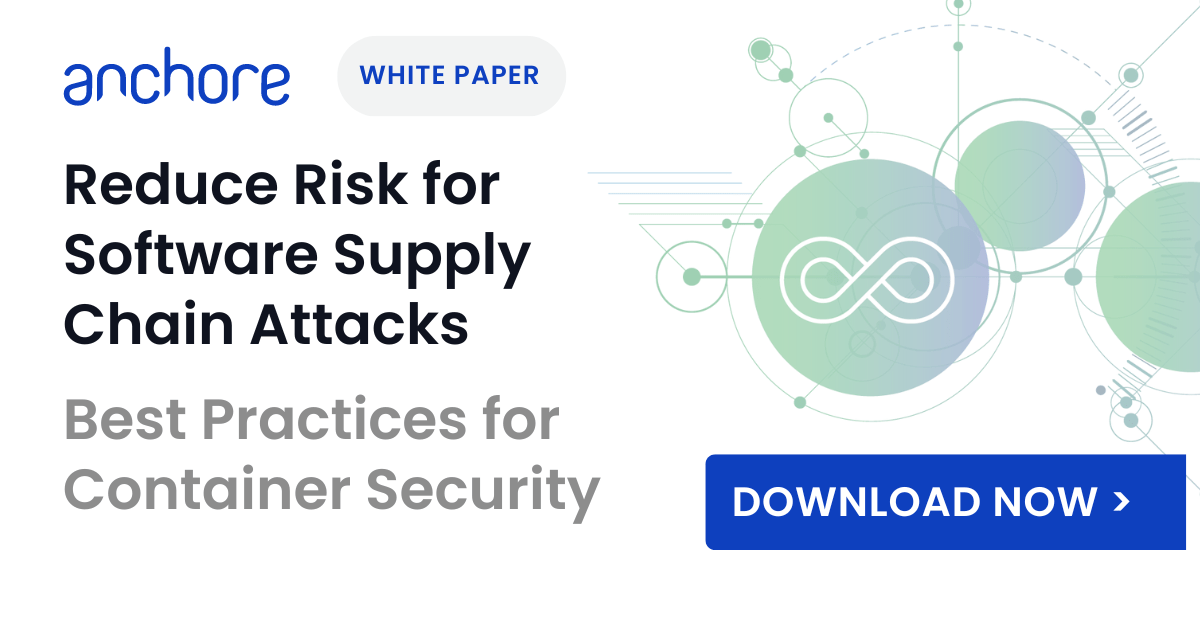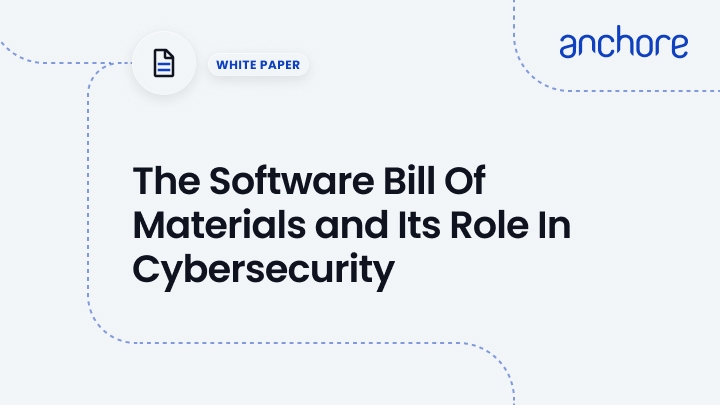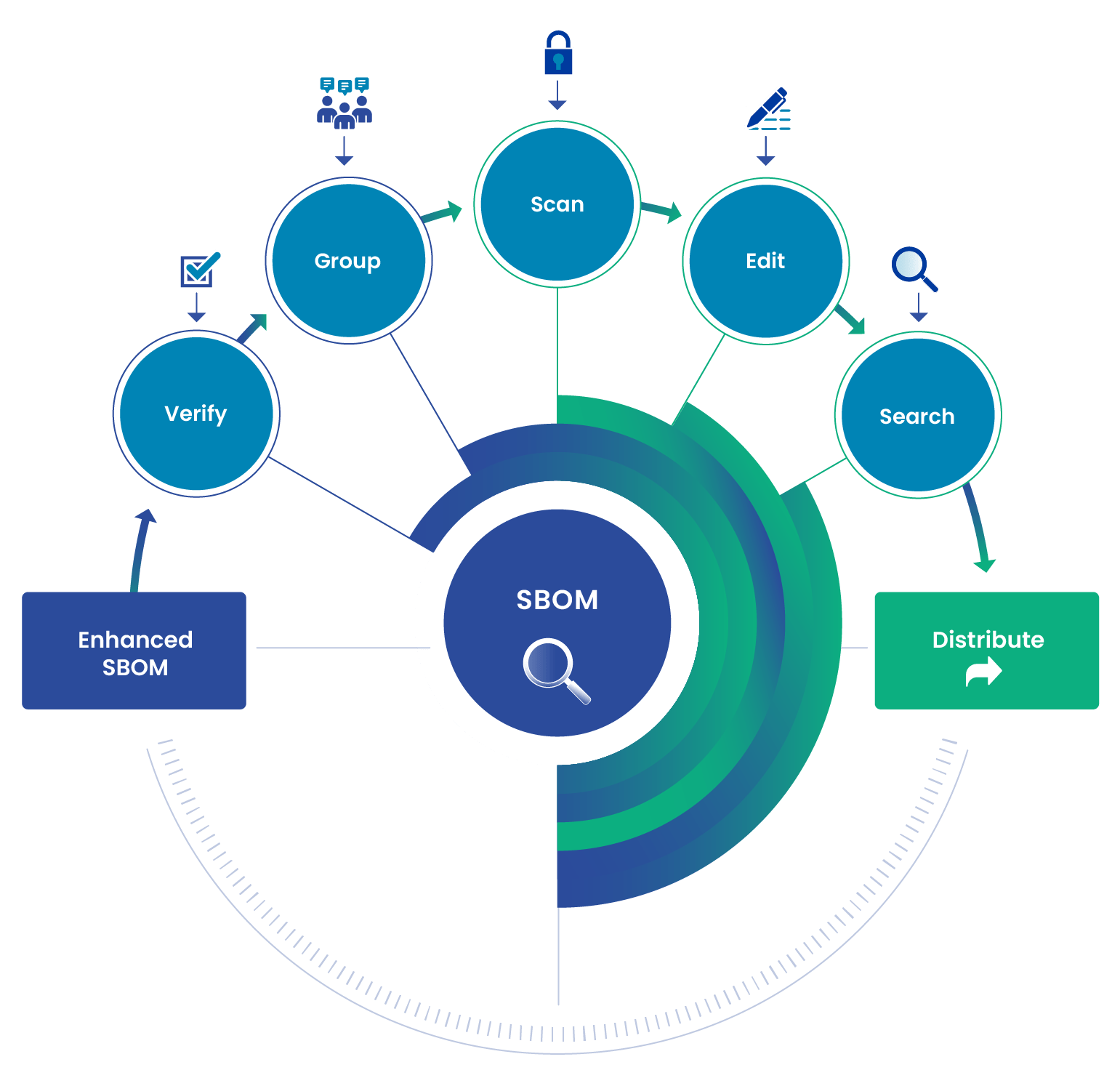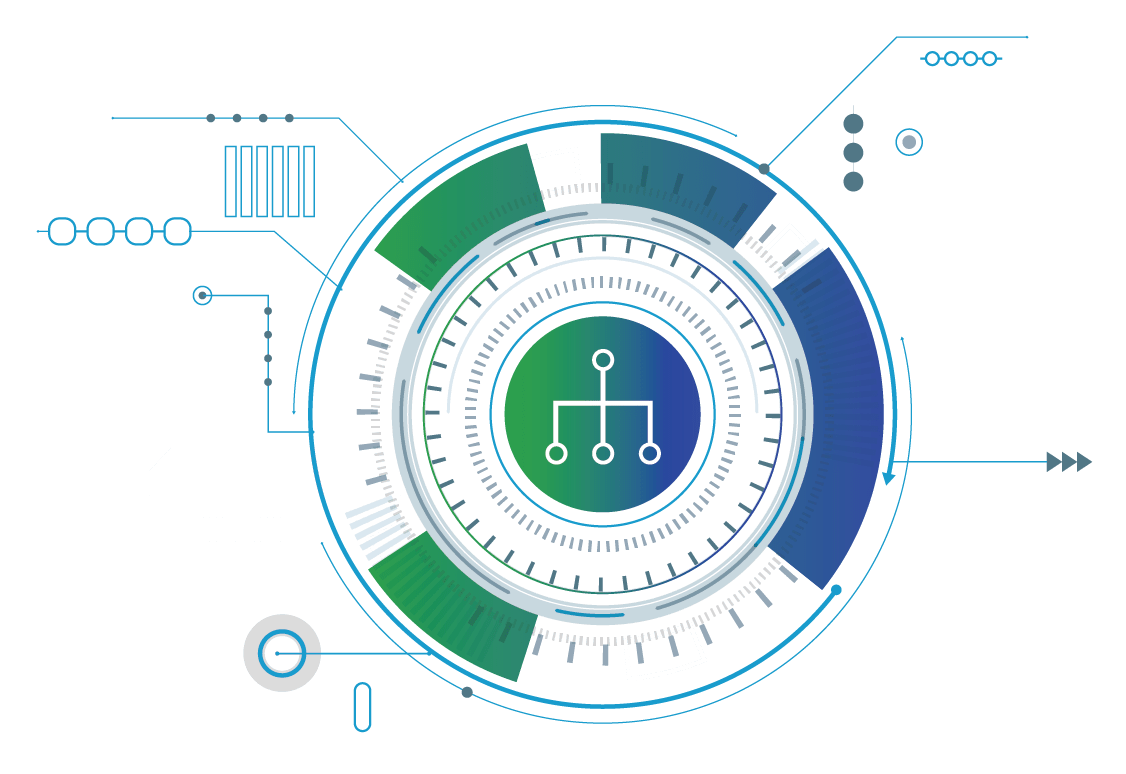The software industry has wholeheartedly adopted the practice of building new software on the shoulders of the giants that came before them. To accomplish this developers construct a foundation of pre-built, 3rd-party components together then wrap custom 1st-party code around this structure to create novel applications. It is an extraordinarily innovative and productive practice but it also introduces challenges ranging from security vulnerabilities to compliance headaches to legal risk nightmares. Software bills of materials (SBOMs) have emerged to provide solutions for these wide ranging problems.
An SBOM provides a detailed inventory of all the components that make up an application at a point in time. However, it’s important to recognize that not all SBOMs are the same—even for the same piece of software! SBOMs evolve throughout the DevSecOps lifecycle; just as an application evolves from source code to a container image to a running application. The Cybersecurity and Infrastructure Security Agency’s (CISA) has codified this idea by differentiating between all of the different types of SBOMs. Each type serves different purposes and captures information about an application through its evolutionary process.
In this 2-part blog series, we’ll deep dive into each stage of the DevSecOps process and the associated SBOM. Highlighting the differences, the benefits and disadvantages and the use-cases that each type of SBOM supports. Whether you’re just beginning your SBOM journey or looking to deepen your understanding of how SBOMs can be integrated into your DevSecOps practices, this comprehensive guide will provide valuable insights and advice from industry experts.
Types of SBOMs and the DevSecOps Pipeline
Over the past decade the US government got serious about software supply chain security and began advocating for SBOMs as the standardized approach to the problem. As part of this initiative CISA created the Types of Software Bill of Material (SBOM) Documents white paper that codified the definitions of the different types of SBOMs and mapped them to each stage of the DevSecOps lifecycle. We will discuss each in turn but before we do, let’s anchor on some terminology to prevent confusion or misunderstanding.
Below is a diagram that lays out each stage of the DevSecOps lifecycle as well as the naming convention we will use going forward.

With that out of the way, let’s get started!
Plan => Design SBOM
As the DevSecOps paradigm has spread across the software industry, a notable best practice known as the security architecture review has become integral to the development process. This practice embodies the DevSecOps goal of integrating security into every phase of the software lifecycle, aligning perfectly with the concept of Shift-Left Security—addressing security considerations as early as possible.
At this stage, the SBOM documents the planned components of the application. The CISA refers to SBOMs generated during this phase as Design SBOMs. These SBOMs are preliminary and outline the intended components and dependencies before any code is written.
The metadata that is collected for a Design SBOM includes:
- Component Inventory: Identifying potential OSS libraries and frameworks to be used as well as the dependency relationship between the components.
- Licensing Information: Understanding the licenses associated with selected components to ensure compliance.
- Risk Assessment Data: Evaluating known vulnerabilities and security risks associated with each component.
This might sound like a lot of extra work but luckily if you’re already performing DevSecOps-style planning that incorporates a security and legal review—as is best practice—you’re already surfacing all of this information. The only thing that is different is that this preliminary data is formatted and stored in a standardized data structure, namely an SBOM.
Pros and Cons
Pros:
- Maximal Shift-Left Security: Vulnerabilities cannot be found any earlier in the software development process. Design time security decisions are the peak of a proactive security posture and preempt bad design decisions before they become ingrained into the codebase.
- Cost Efficiency: Resolving security issues at this stage is generally less expensive and less disruptive than during later stages of development or—worst of all—after deployment.
- Legal and Compliance Risk Mitigation: Ensures that all selected components meet necessary compliance standards, avoiding legal complications down the line.
Cons:
- Upfront Investment: Gathering detailed information on potential components and maintaining an SBOM at this stage requires a non-trivial commitment of time and effort.
- Incomplete Information: Projects are not static, they will adapt as unplanned challenges surface. A design SBOM likely won’t stay relevant for long.
Use-Cases
There are a number of use-cases that are enabled by
- Security Policy Enforcement: Automatically checking proposed components against organizational security policies to prevent the inclusion of disallowed libraries or frameworks.
- License Compliance Verification: Ensuring that all components comply with the project’s licensing requirements, avoiding potential legal issues.
- Vendor and Third-Party Risk Management: Assessing the security posture of third-party components before they are integrated into the application.
- Enhance Transparency and Collaboration: A well-documented SBOM provides a clear record of the software’s components but more importantly that the project aligns with the goals of all of the stakeholders (engineering, security, legal, etc). This builds trust and creates a collaborative environment that increases the chances of each individual stakeholder outcome will be achieved.
Example:
A financial services company operating within a strict regulatory environment uses SBOMs during planning to ensure that all components comply with compliance standards like PCI DSS. By doing so, they prevent the incorporation of insecure components that won’t meet PCI compliance. This reduces the risk of the financial penalties associated with security breaches and regulatory non-compliance.
Pro Tip
If your organization is still early in the maturity of its SBOM initiative then we generally recommend moving the integration of design time SBOMs to the back of the queue. As we mention at the beginning of this the information stored in a design SBOMs is naturally surfaced during the DevSecOps process, as long as the information is being recorded and stored much of the value of a design SBOM will be captured in the artifact. This level of SBOM integration is best saved for later maturity stages when your organization is ready to begin exploring deeper levels of insights that have a higher risk-to-reward ratio.
Alternatively, if your organization is having difficulty getting your teams to adopt a collaborative DevSecOps planning process mandating a SBOM as a requirement can act as a forcing function to catalyze a cultural shift.
Source => Source SBOM
During the development stage, engineers implement the selected 3rd-party components into the codebase. CISA refers to SBOMs generated during this phase as Source SBOMs. The SBOMs generated here capture the actual implemented components and additional information that is specific to the developer who is doing the work.
The additional metadata that is collected for a Source SBOM includes:
- Dependency Mapping: Documenting direct and transitive dependencies.
- Identity Metadata: Adding contributor and commit information.
- Developer Environment: Captures information about the development environment.
Unlike Design SBOMs which are typically done manually, these SBOMs can be generated programmatically with a software composition analysis (SCA) tool—like Syft. They are usually packaged as command line interfaces (CLIs) since this is the preferred interface for developers.
If you’re looking for an SBOM generation tool (SCA embedded), we have a comprehensive list of options to make this decision easier.
Pros and Cons
Pros:
- Accurate and Timely Component Inventory: Reflects the actual components used in the codebase and tracks changes as codebase is actively being developed.
- Shift-Left Vulnerability Detection: Identifies vulnerabilities as components are integrated but requires commit level automation and feedback mechanisms to be effective.
- Facilitates Collaboration and Visibility: Keeps all stakeholders members informed about divergence from the original plan and provokes conversations as needed. This is also dependent on automation to record changes during development and the notification systems to broadcast the updates.
Example: A developer adds a new logging library to the project like an outdated version of Log4j. The SBOM, paired with a vulnerability scanner, immediately flags the Log4Shell vulnerability, prompting the engineer to update to a patched version.
Cons:
- Noise from Developer Toolchains: A lot of times developer environments are bespoke. This creates noise for security teams by recording development dependencies.
- Potential Overhead: Continuous updates to the SBOM can be resource-intensive when done manually; the only resource efficient method is by using an SBOM generation tool that automates the process.
- Possibility of Missing Early Risks: Issues not identified during planning may surface here, requiring code changes.
Use-Cases
- Faster Root Cause Analysis: During service incident retrospectives questions about where, when and by whom a specific component was introduced into an application. Source SBOMs are the programmatic record that can provide answers and decrease manual root cause analysis.
- Real-Time Security Alerts: Immediate notification of vulnerabilities upon adding new components, decreasing time to remediation and keeping security teams informed.
- Automated Compliance Checks: Ensuring added components comply with security or license policies to manage compliance risk.
- Effortless Collaboration: Stakeholders can subscribe to a live feed of changes and immediately know when implementation diverges from the plan.
Pro Tip
Some SBOM generators allow developers to specify development dependencies that should be ignored, similar to .gitignore file. This can help cut down on the noise created by unique developer setups.
Build & Test => Build SBOM
When a developer pushes a commit to the CI/CD build system an automated process initiates that converts the application source code into an artifact that can then be deployed. CISA refers to SBOMs generated during this phase as Build SBOMs. These SBOMs capture both source code dependencies and build tooling dependencies.
The additional metadata that is collected includes:
- Build Dependencies: Build tooling such as the language compilers, testing frameworks, package managers, etc.
- Binary Analysis Data: Metadata for compiled binaries that don’t utilize traditional container formats.
- Configuration Parameters: Details on build configuration files that might impact security or compliance.
Pros and Cons
Pros:
- Build Infrastructure Analysis: Captures build-specific components which may have their own vulnerability or compliance issues.
- Reuses Existing Automation Tooling: Enables programmatic security and compliance scanning as well as policy enforcement without introducing any additional build tooling.
- Reuses Existing Automation Tooling: Directly integrates with developer workflow. Engineers receive security, compliance, etc. feedback without the need to reference a new tool.
- Reproducibility: Facilitates reproducing builds for debugging and auditing.
Cons:
- SBOM Sprawl: Build processes run frequently, if it is generating an SBOM with each run you will find yourself with a glut of files that you will have to manage.
- Delayed Detection: Vulnerabilities or non-compliance issues found at this stage may require rework.
Use-Cases
- SBOM Drift Detection: By comparing SBOMs from two or more stages, unexpected dependency injection can be detected. This might take the form of a benign, leaky build pipeline that requires manual workarounds or a malicious actor attempting to covertly introduce malware. Either way this provides actionable and valuable information.
- Policy Enforcement: Enables the creation of build breaking gates to enforce security or compliance. For high-stakes operating environments like defense, financial services or critical infrastructure, automating security and compliance at the expense of some developer friction is a net-positive strategy.
- Automated Compliance Artifacts: Compliance requires proof in the form of reports and artifacts. Re-utilizing existing build tooling automation to automate this task significantly reduces the manual work required by security teams to meet compliance requirements.
Example: A security scan during testing uses the Build SBOM to identify a critical vulnerability and alerts the responsible engineer. The remediation process is initiated and a patch is applied before deployment.
Pro Tip
If your organization is just beginning their SBOM journey, this is the recommended phase of the DevSecOps lifecycle to implement SBOMs first. The two primary cons of this phase can be mitigated the easiest. For SBOM sprawl, you can procure a turnkey SBOM management solution like Anchore SBOM.
As for the delay in feedback created by waiting till the build phase, if your team is utilizing DevOps best practices and breaking features up into smaller components that fit into 2-week sprints then this tight scoping will limit the impact of any significant vulnerabilities or non-compliance discovered.
Intermission
So far we’ve covered the first half of the DevSecOps lifecycle. Next week we will publish the second part of this blog series where we’ll cover the remainder of the pipeline. Watch our socials to be sure you get notified when part 2 is published.
If you’re looking for some additional reading in the meantime, check out our container security white paper below.
Learn the 5 best practices for container security and how SBOMs play a pivotal role in securing your software supply chain.






